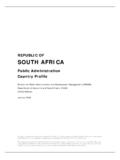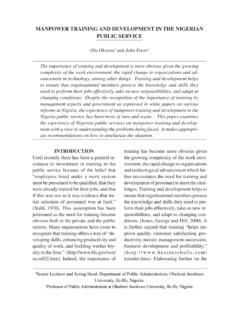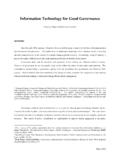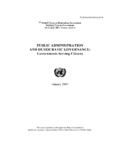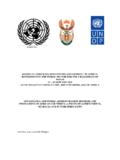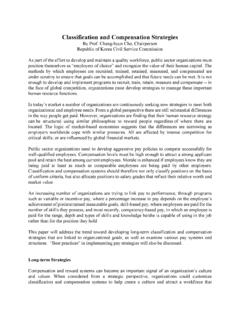Transcription of White Paper on Transforming Public Sector Delivery
1 White Paper ON Transforming Public SERVICE Delivery Department of Public Service and Administration 18 September 1997 FOREWORD By Zola Skweyiya, Minister for Public Service and Administration (not available here) 1. INTRODUCTION A guiding principle of the Public service in South Africa will be that of service to the people Purpose The White Paper on the Transformation of the Public Service (WPTPS), published on 24 November 1995, sets out eight transformation priorities, amongst which Transforming Service Delivery is the key. This is because a transformed South African Public service will be judged by one criterion above all: its effectiveness in delivering services which meet the basic needs of all South African citizens. Improving service Delivery is therefore the ultimate goal of the Public service transformation programme.
2 (Figure 1 not available) Figure 1: Transforming Service Delivery the Key Transformation Priority The purpose of this White Paper is to provide a policy framework and a practical implementation strategy for the transformation of Public service Delivery . This White Paper is primarily about how Public services are provided, and specifically about improving the efficiency and effectiveness of the way in which services are delivered. It is not about what services are to be provided their volume, level and quality which is a matter for Ministers, Members of the Executive Councils (MECS), other executing authorities and the duly appointed heads of government institutions. However, their decisions about what should be delivered will be improved as a result of the Batho Pele approach, for example through systematic consultation with users of services, and by information about whether standards of service are being met in practice.
3 Background Public services are not a privilege in a civilised and democratic society: they are a legitimate expectation. That is why meeting the basic needs of all citizens is one of the five key programmed of the Government s Reconstruction and Development Programme (RDP). It is also the reason why the Government s macro-economic strategy called Growth, Employment and Redistribution (GEAR) calls, among other things, for the reduction in unnecessary government consumption and the release of resources for productive investment and their redirection to areas of greatest need. This means that government institutions must be reoriented to optimise access to their services by all citizens, within the context of fiscal constraints and the fulfillment of competing needs. The Constitution, 1996 stipulates that Public administration should adhere to a number of principles, including that: * a high standard of professional ethics be promoted and maintained; * services be provided impartially, fairly , equitably and without bias; * resources be utilised efficiently, economically and effectively; * peoples needs be responded to; * the Public be encouraged to participate in policy-making; and * it be accountable, transparent and development-oriented.
4 The Constitution, through the Bill of Rights, also give citizens certain rights to take action against the state if they believe their constitutional rights have been infringed, and to have access to information held by the state which they need in order to be able to do so. In line with these Constitutional principles, the WPTPS calls on all national and provincial departments to make service Delivery a priority, The WPTPS also provides a framework to enable national and provincial departments to develop departmental service Delivery strategies. These strategies will need to promote continuous improvements in the quantity, quality and equity of service provision. Chapter 11 of the WPTPS requires national and provincial departments to identify, among other things: * a mission statement for service Delivery , together with service guarantees: * the services to be provided, to which groups, and at which service charges; * in line with RDP priorities, the principle of affordability, and the principle of redirecting resources to areas and groups previously under-resourced; * service standards, defined outputs and targets, and performance indicators, benchmarked against comparable international standards; * monitoring and evaluation mechanisms and structures, designed to measure progress and introduce corrective action, where appropriate; * plans for staffing, human resource development and organisational capacity building, tailored to service Delivery needs.
5 * the redirection of human and other resources from administrative tasks to service provision, particularly for disadvantaged groups and areas; * financial plans that link budgets directly to service needs and personnel plans: * potential partnerships with the private Sector , non-governmental organisations (NGOS) and community-based organisations (CBOS) which will provide more effective forms of service Delivery ; and * the development, particularly through training, of a culture of customer care and of approaches to service Delivery that are sensitive to issues of race, gender and disability. The WPTPS specifies, further, that in order to ensure that service Delivery is constantly improved, national and provincial departments will be required to outline their specific short, medium and long term goals for service provision.
6 They will also be required to provide annual and five yearly targets for the Delivery of specific services, and will be required to report to their respective national and provincial legislatures on their achievements. Improving the Delivery of Public services means redressing the imbalances of the past and, while maintaining continuity of service to all levels of society, focusing on meeting the needs of the 40V0 of South Africans who are living below the poverty line and those, such) as the disabled, and black women living in rural areas, who have previously been disadvantaged in terms of service Delivery . ~ Improving service Delivery also calls for a shift away from inward-looking, bureaucratic systems, processes and attitudes, and a search for new ways of working which put the needs of the Public first, is better, faster and more responsive to the citizens needs.
7 It also means a complete change in the way that services are delivered. The objectives of service Delivery therefore include welfare, equity and efficiency. The introduction of a service Delivery improvement programme cannot be achieved in isolation from other fundamental management changes within the Public service. It must be part of a fundamental shift of culture whereby Public servants see themselves first and foremost as servants of the citizens of South Africa, and where the Public Service is managed with service to the Public as its primary goal. Improved service Delivery cannot only be implemented by issuing circulars. It is not only about rule-books and prescripts , because it is not simply an administrative activity. It is a dynamic process out of which a completely new relationship is developed between the Public service and its individual clients.
8 To implement a service Delivery programme successfully, Public service managers require new management tools. These tools are, broadly, the tools of the new Public service management . In essence these are: * assignment to individual managers of responsibility for delivering specific results for a specified level of resources and for obtaining value for money in the use of those resources; * individual responsibility for results matched with managerial authority for decisions about how resources should be used; * delegation of managerial responsibility and authority to the lowest possible level; and * transparency about the results achieved and resources consumed. These ideas are not strange to South Africa they are enshrined in the WPTPS. However, the Public Service is generally still quite a long way from implementing them.
9 The Public Service is currently perceived as being characterized by, for example, inequitable distribution of Public services, especially in rural areas, lack of access services, lack of transparency and openness and consultation on the required service standards, lack of accurate and simple information on services and standards at which they are rendered, lack of responsiveness and insensitiveness towards citizens complaints, and discourteous staff. These perceptions, which are frequently reflected in media reporting of Public Service activities, are also shared by many Public servants themselves, as was confirmed during the consultation process which preceded the preparation of this White Paper and the WPTPS. The Public Service is also seen as still operating within over-centralised, hierarchical and rule-bound systems inherited from the previous dispensation, which make it difficult to hold individuals to account because: * decision-making is diffused; * they are focused on inputs father than on outcomes.
10 * they do not encourage value for money; ~ * they do not reward innovation and creativity; * they reward uniformity above effectiveness and responsiveness; and * they encourage inward-looking, inflexible attitudes which are at odds with the vision of a Public service whose highest aim is service to the people. Many of these outdated systems and practices are now being tackled, and the next few years will see major reforms, for example, in budgeting and human resource management, which will delegate to national and provincial departments substantial authority and accountability for service Delivery , as well as greater flexibility to manage their operations in line with their developmental objectives. ~ It might be argued that internal management reforms should be completed before attempting to introduce a service Delivery improvement programme.
